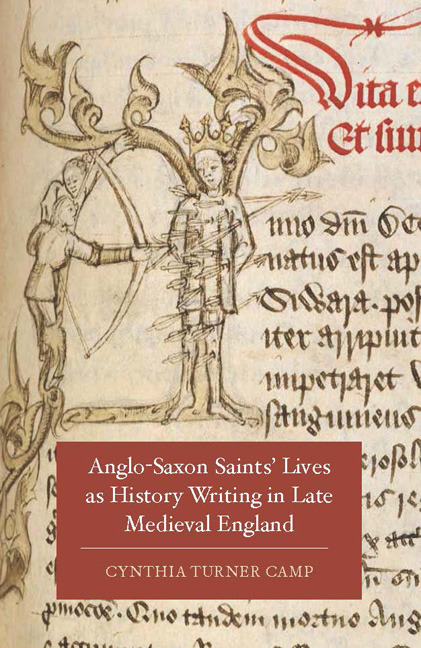Book contents
- Frontmatter
- Dedication
- Contents
- List of Illustrations
- Acknowledgments
- Abbreviations
- Introduction
- 1 Edith of Wilton and the Writing of Women's History
- 2 Audrey Abroad: Spiritual and Genealogical Filiation in the Middle English Lives of Etheldreda
- 3 Henry Bradshaw's Life of Werburge and the Limits of Holy Incorruption
- 4 The Limits of Narrative History in the Written and Pictorial Lives of Edward the Confessor
- 5 The Limits of Poetic History in Lydgate's Edmund and Fremund and the Harley 2278 Pictorial Cycle
- Bibliography
- Index
5 - The Limits of Poetic History in Lydgate's Edmund and Fremund and the Harley 2278 Pictorial Cycle
Published online by Cambridge University Press: 05 May 2015
- Frontmatter
- Dedication
- Contents
- List of Illustrations
- Acknowledgments
- Abbreviations
- Introduction
- 1 Edith of Wilton and the Writing of Women's History
- 2 Audrey Abroad: Spiritual and Genealogical Filiation in the Middle English Lives of Etheldreda
- 3 Henry Bradshaw's Life of Werburge and the Limits of Holy Incorruption
- 4 The Limits of Narrative History in the Written and Pictorial Lives of Edward the Confessor
- 5 The Limits of Poetic History in Lydgate's Edmund and Fremund and the Harley 2278 Pictorial Cycle
- Bibliography
- Index
Summary
In the winter and spring of 1434, Bury St Edmunds Abbey hosted the young King Henry VI, just twelve years of age, and his retinue for Christmas, Lent, and Easter. This visit was a coup for the abbey, for it ensured that its abbot, the redoubtable William Curteys, would have the king's ear for several months. Curteys capitalized on the opportunity, greeting Henry with pomp, providing him with hunting opportunities, guiding his veneration at St Edmund's shrine, and commissioning the abbey's resident poet, John Lydgate, to compose for him a poem about Edmund. Some years later, Henry was presented with that poem as a memorial of his visit: now BL, Harley MS 2278, a regal codex containing Edmund and Fremund enhanced by an elaborate series of illustrations. Abbey and crown enjoyed a cordial relationship for many years after this visit: Henry and his retinue were admitted into the abbey's confraternity shortly before departing, in 1447 Henry issued a charter confirming Bury St Edmunds' long held rights, and Curteys become one of the king's valued advisers.
Edmund was, alongside Edward the Confessor, one of England's most wellknown native saints, famous for his ninth-century martyrdom at the hands of the pagan Danes, his bodily incorruption, and his thaumaturgical powers. Lydgate's Edmund and Fremund, particularly when read alongside the Harley 2278 images, is the high point of Edmund's continuous and vibrant cult. Hagiographers from Bury St Edmunds and beyond had rewritten narratives of Edmund's career and death in every vernacular spoken in England and in nearly every century since Abbo of Fleury penned the first Vita Edmundi in the 980s. He appears in each of the major Middle English legendaries and, unlike many saints whose late medieval monasteries were content with their twelfth- or thirteenth-century hagiographies, he received five new vitae at Bury after 1375. Appearing in religious art (as on the Wilton Diptych) crowned and holding a sheaf of arrows, Edmund was a familiar figure in parish churches as well as royal iconography.
- Type
- Chapter
- Information
- Publisher: Boydell & BrewerPrint publication year: 2015



